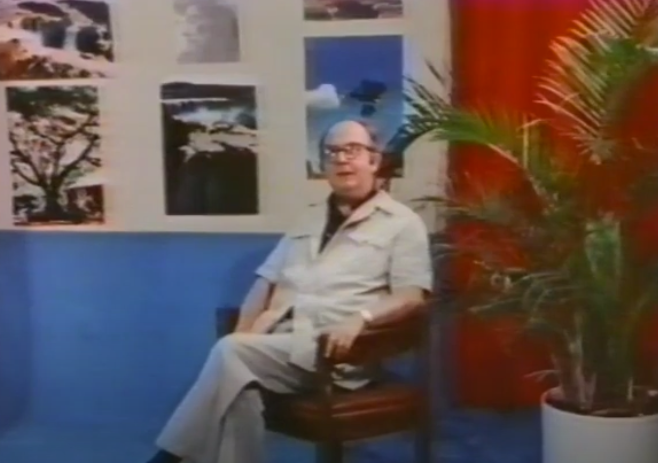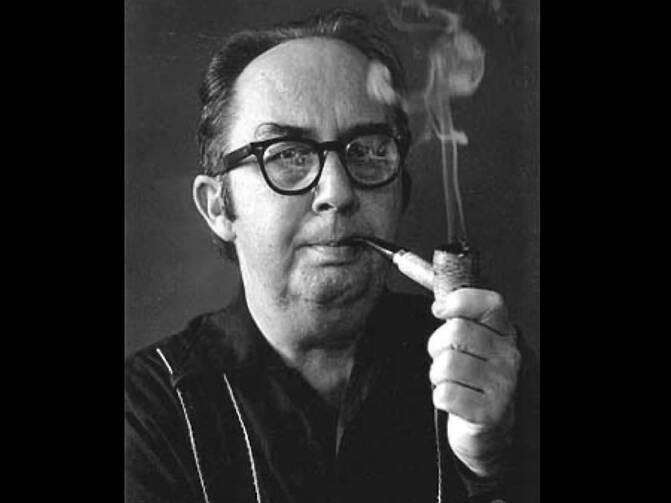At 114 years of age, America has an immense catalog of former editors and contributors, many of them colorful characters who would have been a hoot to meet in person: Francis X. Talbot, S.J., and Harold Gardiner, S.J., two cranky but hilarious literary editors; Moira Walsh, a longtime film reviewer who knew (that she knew) more about movies than anyone alive; Mary McGrory, the “First Queen of Journalism” who made it onto Nixon’s enemies list; and Leonard Feeney, S.J., a fiery poet who got himself excommunicated (after he left America).
And then there is the true G.O.A.T., Clement James McNaspy, S.J.
The picture above, mirabile dictu, actually does not do this former associate editor of America (1960 to 1970) justice; he was actually far more intriguing than that saucy fellow enjoying a pipeful. In fact, I would venture to argue that Father McNaspy (that’s C.J. if you’re Naspy) was for a time the most interesting Jesuit in the world.
In 1971, Father McNaspy participated in a special issue of Liturgical Arts that discussed the possibility of a submarine church that would travel around the world promoting peace and ecology.
I first encountered Father C. J. McNaspy in a bit of oral history passed down from editor to editor at America. In the early 1970s, the Jesuits were rethinking the traditional model of Jesuit training, which involved years of study at institutions that were usually far removed from social concerns or societal interaction. Why not, Father McNaspy suggested, buy one of the new Boeing 747s and fly all the Jesuits in formation around the country, visiting various apostolates and giving them exposure to the environments in which they would minister in the future?
The ambitious plan went nowhere, with cost being perhaps a secondary obstacle to a more primary question: What if the plane crashed?

Born in 1915, C. J. McNaspy joined the Society of Jesus in 1931 at the age of 16. Ordained in 1944, he earned a doctorate in music from the University of Montreal in 1948, then studied for a year at Oxford. He moved on to teach at Loyola University of New Orleans (where he also served as dean of the college of music), during which time he also wrote a column for the archdiocesan newspaper called “Hemidemisemiquavers.” A former student of Marshall McLuhan, Father McNaspy kept up a correspondence with him for years. In the 1960s, he edited “Music for Everyman,” a series of 60 recordings for the American Record Society.
At Loyola, Father McNaspy taught everything from classics to philosophy to fine arts to music to languages and liturgy. Fluent in numerous languages, he wrote academic articles for journals in Dutch, English, French and Spanish. Later in life, as a missionary in Paraguay, he wrote a book in 1982 with the photographer Jose Maria Blanch, The Lost Cities of Paraguay, which became the inspiration for the movie “The Mission.” (Father McNaspy served as a consultant on the film.)
When he died in 1995, his obituary in The New York Times credited him with writing 29 books on topics ranging from A Guide to the Enjoyment of Music, Conquistador Without Sword: The Life of Roque Gonzalez, S.J., Our Changing Liturgy, A Guide to Christian Europe, Change not Changes; New Directions in Religious Life and Priesthood and many more subjects both popular and obscure. His Play On! Memoirs of a Jesuit Teacher was published posthumously in 1996.
McNaspy and another priest waited until the dead of night to sneak the piano in—forgetting in the meantime that his bedroom was directly above that of the Jesuit superior who had told him no.
Among his favorite topics when he was at America? The Soviet Union; Latin America; Eastern Europe; race relations in the American South; liturgy; music history; architecture (he once denounced New York City for “its wanton and savage insouciance” about its own architectural heritage); art and art history; and linguistics. His America articles include a review of a theology tome by Johann Baptist Metz and a 1973 essay on the history of the song “Happy Birthday.” His judgment of the tune? “Altogether not bad, even if not quite Bach.”
Father McNaspy allowed his imagination to run a bit wild in 1971, when he participated in a special issue of Liturgical Arts that discussed the possibility of a submarine church that would travel around the world promoting peace and ecology. (It was an experimental time, liturgically speaking: Four years earlier, the same magazine had proposed a chapel on the moon.) The proposed submarine chapel would be named “Bea,” both in honor of Cardinal Augustin Bea, S.J., the prelate who played an important role at the Second Vatican Council and served as the first president of the Secretariat for Promoting Christian Unity, and Charles Darwin’s ship, “The Beagle.” In his essay, Father McNaspy called the 1960s “the decade of outer space,” while the 1970s would be the decade “of inner space.”
Of all of Father McNaspy’s enthusiasms, however, the one that most captured his attention during his time at America was the liturgy—and specifically the translation of the Roman Missal into the vernacular after Vatican II. “Our American bishops’ petition to have the Canon of the Mass said in English is now granted,” Father McNaspy wrote in 1967 in an article presenting two possible new canons for the Mass:
We have secured the permission of two distinguished young theologian-writers (for the combination seems unfortunately rare) to publish canons that they have composed. Both texts are copyrighted.The first is by Fr. John L’Heureux, S.J. (Quick as Dandelions and Rubrics for a Revolution), and the second, by Fr. Donald Gelpi, S.J. (Life and Light: A Guide to the Theology of Karl Rahner and Functional Asceticism). They demonstrate two types of canons, different in flavor yet both profoundly traditional, that may open the way to further exploration. Theologians with a gift of words, and poets who know liturgical theology, please take notice.
If the names of those two “distinguished young theologian-writers” sound familiar, it is because they became more prominent in later decades—John L’Heureux as a noted poet and fiction writer and Donald Gelpi, S.J., as an influential theologian. For C.J. McNaspy, their new canons—and the many others being produced around the world in various languages—were an inspiring sign of a liturgical revival still unfolding. “[A]s long as the Mass was recited in a relatively unfamiliar tongue, monotony was bearable, indeed expected; one’s thoughts could drift piously into variegated meditation while the prescribed words went on more or less mechanically,” he wrote. “Once everything is said in one’s own language, however, a new style of attention becomes both possible and imperative.”
And one final McNaspy legend, this one told by an editor from the 1960s: While an associate editor at America, Father McNaspy asked permission to have a piano in his room in the Jesuit residence. Permission denied. He and another priest then waited until the dead of night to sneak the piano in—forgetting in the meantime that his bedroom was directly above that of the Jesuit superior who had told him no.
I like to think McNaspy charmed his way out of it; or if not, simply moved on to a new enthusiasm.
•••
Our poetry selection for this week is “Fellowship,” by Christian Wiman (who has a new book out). Readers can view all of America’s published poems here.
Also, big news from the Catholic Book Club: This fall, we are reading Come Forth: The Promise of Jesus’s Greatest Miracle, by James Martin, S.J. Click here to watch a livestream with Father Martin about the book or here to sign up for our Facebook discussion group.
In this space every week, America features reviews of and literary commentary on one particular writer or group of writers (both new and old; our archives span more than a century), as well as poetry and other offerings from America Media. We hope this will give us a chance to provide you with more in-depth coverage of our literary offerings. It also allows us to alert digital subscribers to some of our online content that doesn’t make it into our newsletters.
Other Catholic Book Club columns:
The spiritual depths of Toni Morrison
What’s all the fuss about Teilhard de Chardin?
Moira Walsh and the art of a brutal movie review
Leonard Feeney, America’s only excommunicated literary editor (to date)
Happy reading!
James T. Keane








